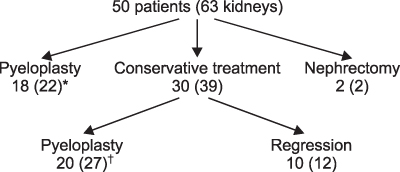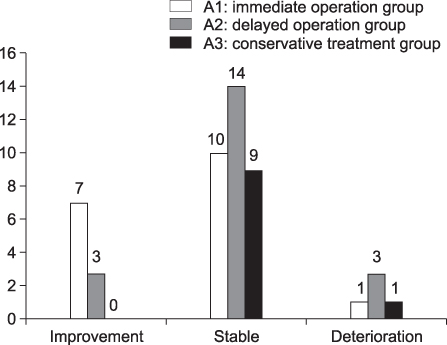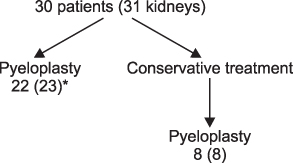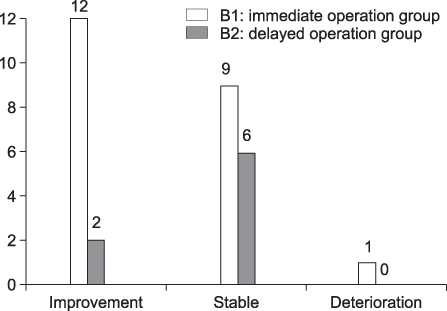Korean J Urol.
2007 Dec;48(12):1302-1307. 10.4111/kju.2007.48.12.1302.
Clinical Course of Pediatric Ureteropelvic Junction Obstruction according to the Age at Diagnosis
- Affiliations
-
- 1Department of Urology, College of Medicine, Kyungpook National University, Daegu, Korea. skchung@knu.ac.kr
- KMID: 1990155
- DOI: http://doi.org/10.4111/kju.2007.48.12.1302
Abstract
-
PURPOSE: There is no agreement concerning the management of ureteropelvic junction obstruction(UPJO) in children. We reviewed our experience over 10 years for children with UPJO to analyze the clinical course and desirable treatment modality.
MATERIALS AND METHODS
We reviewed the medical records of 80 consecutive children with UPJO and they were diagnosed between December 1994 and November 2004. There were 67 boys and 13 girls. A total of 94 kidneys in 80 patients were evaluated with urinalysis, ultrasonography, diuretic renogram and (99m)Tc-DMSA renal scanning. The natural progression of disease, the management method and the perioperative outcomes were retrospectively compared.
RESULTS
Fifty of the 80 patients were prenatally diagnosed by fetal hydronephrosis or who were diagnosed at younger than 1 year(group A), and 30 patients were diagnosed at older than 1 year(group B). In group A, 18 patients underwent dismembered pyeloplasty before 1 year(A1) and 2 patients underwent nephrectomy due to severe deterioration of their renal function(<5%). Among the other 30 patients, delayed pyeloplasties were performed in 20 patients(A2) and 10 patients were managed conservatively(A3). In group B, 22 patients underwent pyeloplasty immediately (B1), and the other 8 patients underwent delayed pyeloplasty(B2). On the comparison of renal functional change among the patients in group A, the A1 patients had better renal functional improvement than the A2 and A3 patients. However, there was no statistical difference between the patients in B1 and B2. The postoperative complication rates were not significantly different in all the groups.
CONCLUSIONS
It is thought that early operation is more effective for improving the renal function in children younger than one year.
Keyword
MeSH Terms
Figure
Reference
-
1. Lim DJ, Lee HM, Choi H. Clinical characteristics and outcome of fetal hydronephrosis. Korean J Urol. 2004. 45:29–33.2. Oh CJ, Seo YJ, Chung SK. Clinical course of prenatally diagnosed ureteropelvic junction obstruction. Korean J Urol. 2003. 44:145–149.3. Kim KS, Kim HS, Lee TK, Park TH, Moon DH, Lee SY, et al. Optimal timing of surgery in neonatal ureteropelvic junction obstruction. Korean J Urol. 1999. 40:1225–1230.4. Sheu JC, Koh CC, Chang PY, Wang NL, Tsai JD, Tsai TC. Ureteropelvic junction obstruction in children: 10 years' experience in one institution. Pediatr Surg Int. 2006. 22:519–523.5. Tal R, Bar-Sever Z, Livne PM. Dismembered pyeloplasty in children: a review of 5 years single center experience. Int J Urol. 2005. 12:1028–1031.6. Fernbach SK, Maizels M, Conway JJ. Ultrasound grading of hydronephrosis: introduction to the system used by the Society for Fetal Urology. Pediatr Radiol. 1993. 23:478–480.7. Tapia J, Gonzalez R. Pyeloplasty improves renal function and somatic growth in children with ureteropelvic junction obstruction. J Urol. 1995. 154:218–222.8. Konda R, Sakai K, Ota S, Abe Y, Hatakeyama T, Orikasa S. Ultrasound grade of hydronephrosis and severity of renal cortical damage on 99m technetium dimercaptosuccinic acid renal scan in infants with unilateral hydronephrosis during followup and after pyeloplasty. J Urol. 2002. 167:2159–2163.9. Sutherland RW, Chung SK, Roth DR, Gonzales ET. Pediatric pyeloplasty: outcome analysis based on patient age and surgical technique. Urology. 1997. 50:963–966.10. Capolicchio G, Leonard MP, Wong C, Jednak R, Brzezinski A, Salle JL. Prenatal diagnosis of hydronephrosis: impact on renal function and its recovery after pyeloplasty. J Urol. 1999. 162:1029–1032.11. DiSandro MJ, Kogan BA. Neonatal management. Role for early intervention. Urol Clin North Am. 1998. 25:187–197.12. Reddy PP, Mandell J. Prenatal diagnosis. Therapeutic implications. Urol Clin North Am. 1998. 25:171–180.13. King LR, Coughlin PW, Bloch EC, Bowie JD, Ansong K, Hanna MK. The case for immediate pyeloplasty in the neonate with ureteroplevic junction obstruction. J Urol. 1984. 132:725–728.14. Dowling KJ, Harmon EP, Ortenberg J, Polanco E, Evans BB. Ureteropelvic junction obstruction: the effect of pyeloplasty on renal function. J Urol. 1988. 140:1227–1230.15. Chung YK, Chang PY, Lin CJ, Wang NL, Sheu JC, Shin BF. Conservative treatment of neonatal hydronephrosis. J Formos Med Assoc. 1992. 91:75–80.16. Koff SA, Campbell K. Nonoperative management of unilateral neonatal hydronephrosis. J Urol. 1992. 148:525–531.17. Ransley PG, Dhillon HK, Gordon I, Duffy PG, Dillon MJ, Barratt TM. The postnatal management of hydronephrosis diagnosed by prenatal ultrasound. J Urol. 1990. 144:584–587.18. Cartwright PC, Duckett JW, Keating MA, Snyder HM 3rd, Escala J, Blyth B, et al. Managing apparent ureteropelvic junction obstruction in the newborn. J Urol. 1992. 148:1224–1228.19. Koff SA, Campbell KD. The nonoperative management of unilateral neonatal hydronephrosis: natural history of poorly functioning kidneys. J Urol. 1994. 152:593–595.20. Chertin B, Pollack A, Koulikov D, Rabinowitz R, Hain D, Hadas-Halpren I, et al. Conservative treatment of ureteropelvic junction obstruction in children with antenatal diagnosis of hydronephrosis: lessons learned after 16 years of follow-up. Eur Urol. 2006. 49:734–739.21. Dejter SW Jr, Eggli DF, Gibbons MD. Delayed management of neonatal hydronephrosis. J Urol. 1988. 140:1305–1309.22. Hafez AT, McLorie G, Bagli D, Khoury A. Analysis of trends on serial ultrasound for high grade neonatal hydronephrosis. J Urol. 2002. 168:1518–1521.23. Austin PF, Cain MP, Rink RC. Nephrostomy tube drainage with pyeloplasty: is it necessarily a bad choice? J Urol. 2000. 163:1528–1530.
- Full Text Links
- Actions
-
Cited
- CITED
-
- Close
- Share
- Similar articles
-
- Endopyelotomy as a Treatment for Ureteropelvic Junction Obstruction: 3 Cases
- Urinary Ascites with Urinoma Secondary to Ureteropelvic Junction Obstruction in an Infant: A Case Report
- Management of the Ureteropelvic Junction Obstruction
- A Case of Congenital Ureteropelvic Junction Obstruction with more than 500 Stones
- Duplicated Collecting System with Lower Pole Ureteropelvic Junct ion Obstruction





